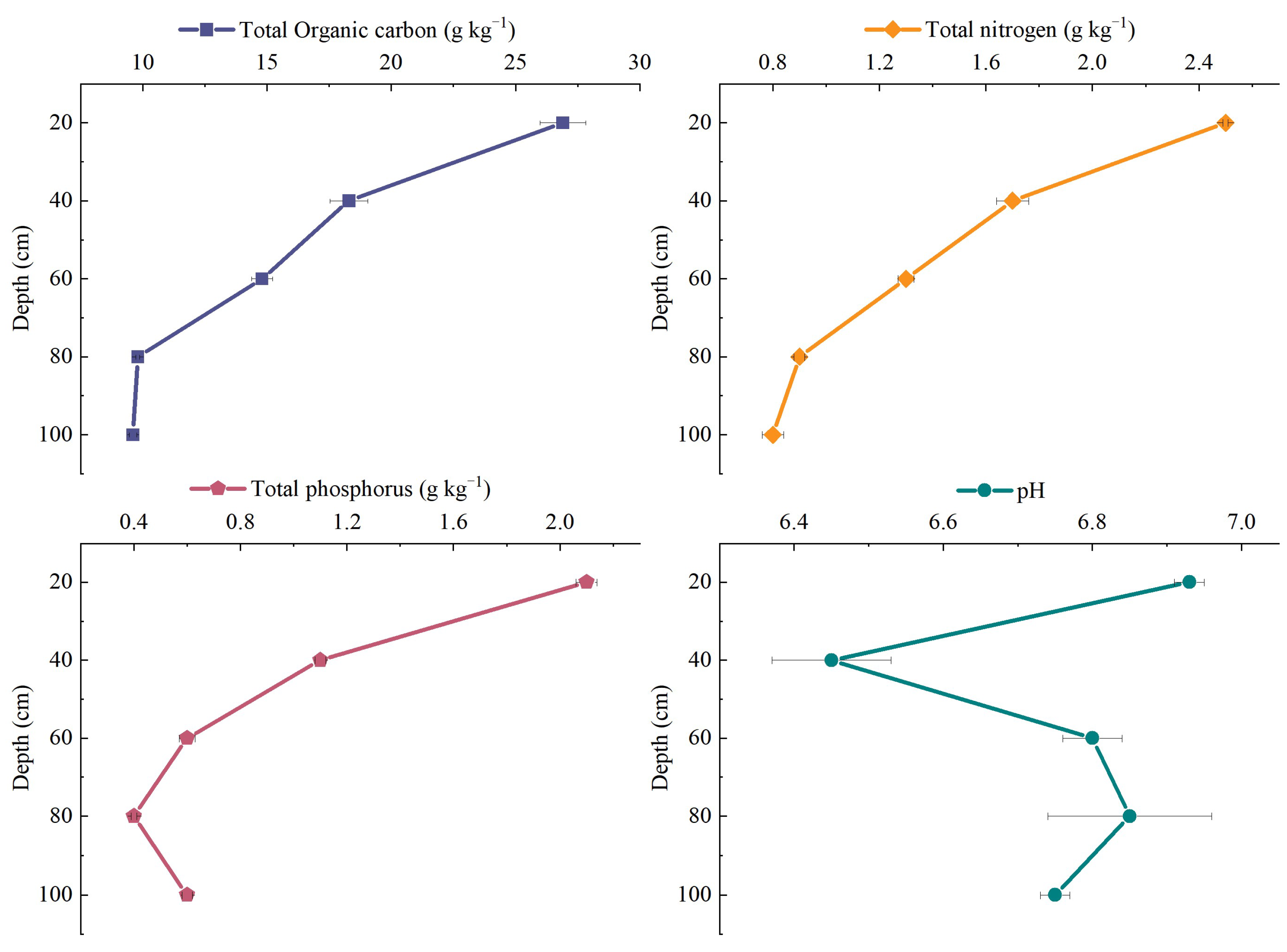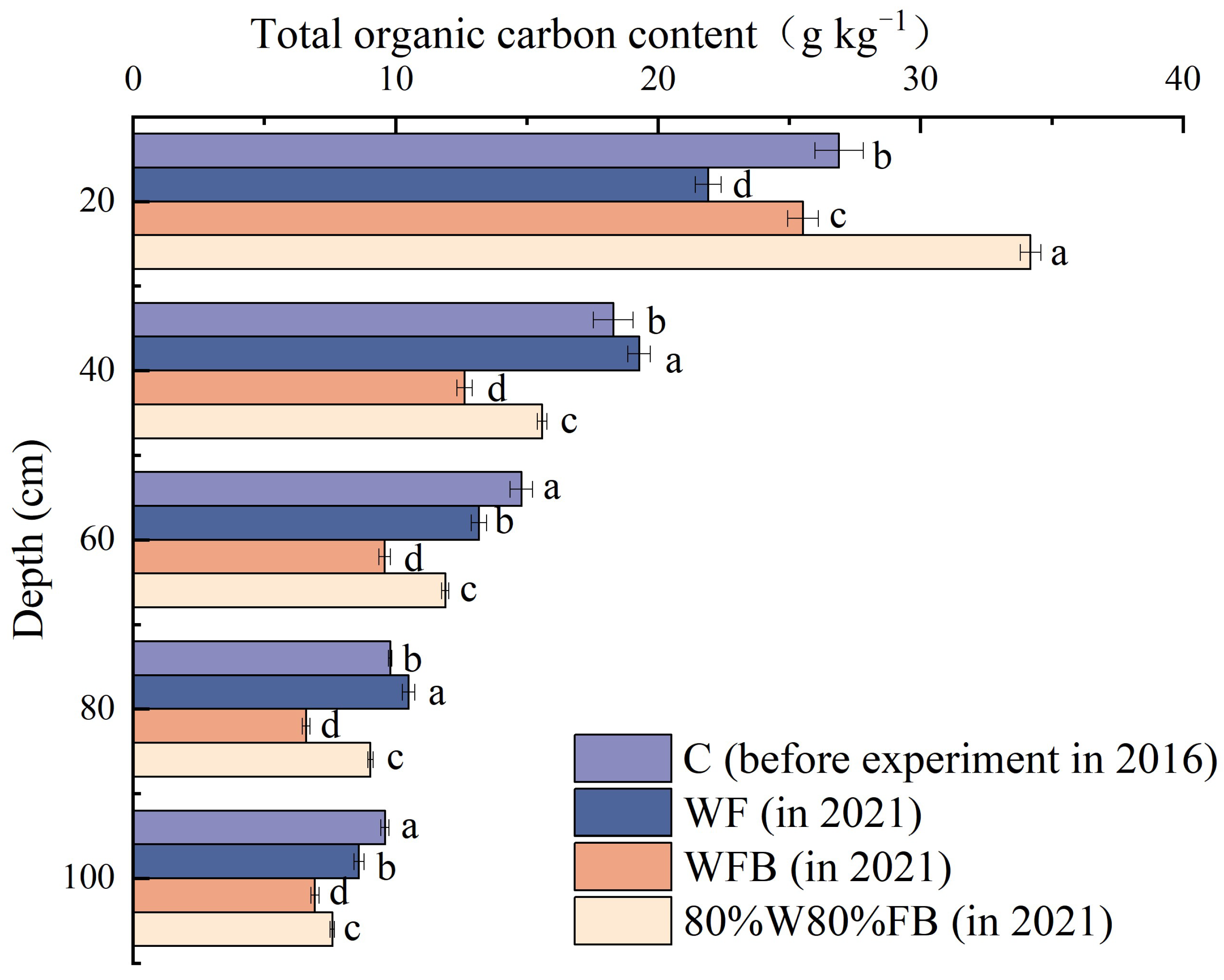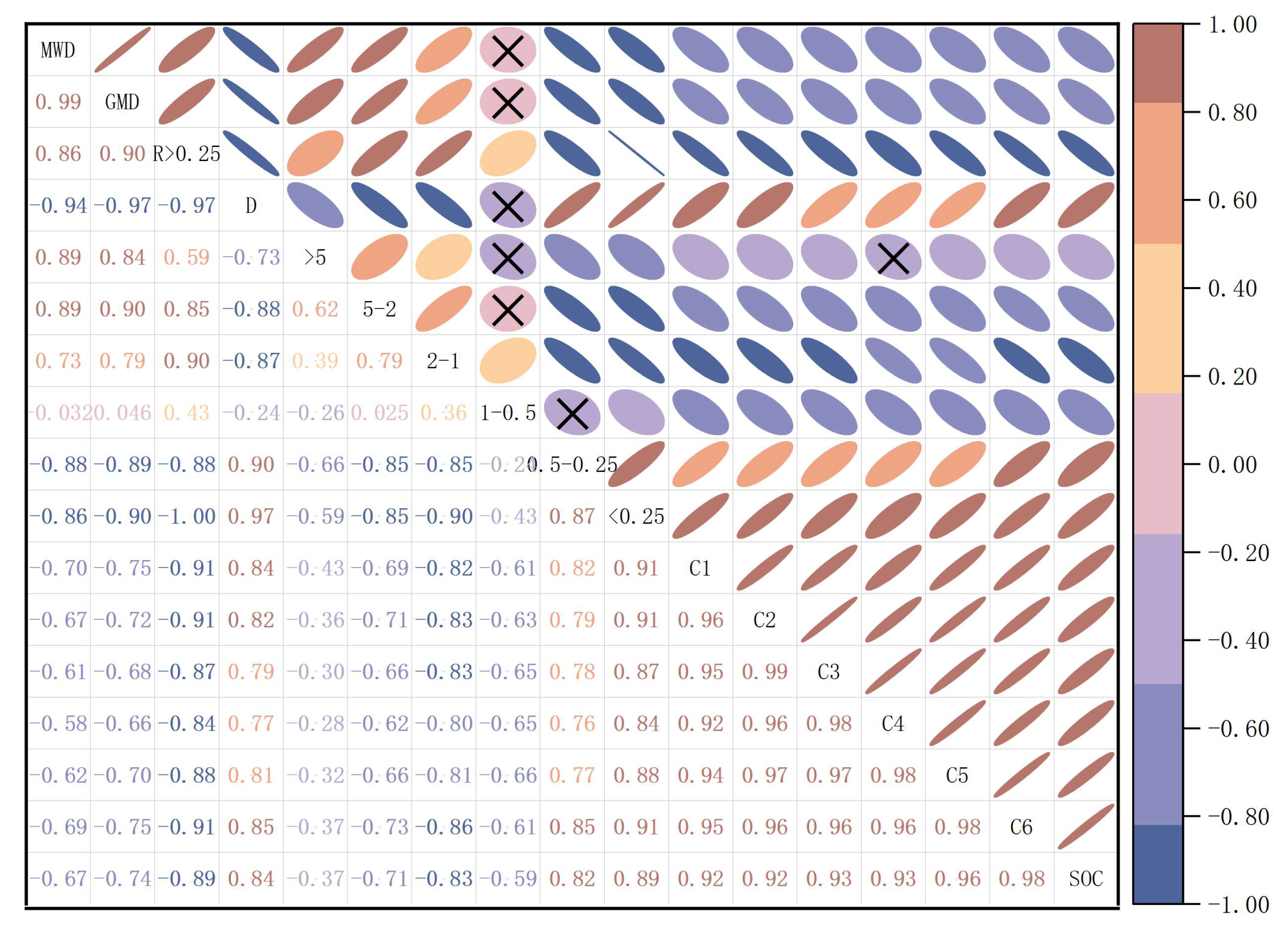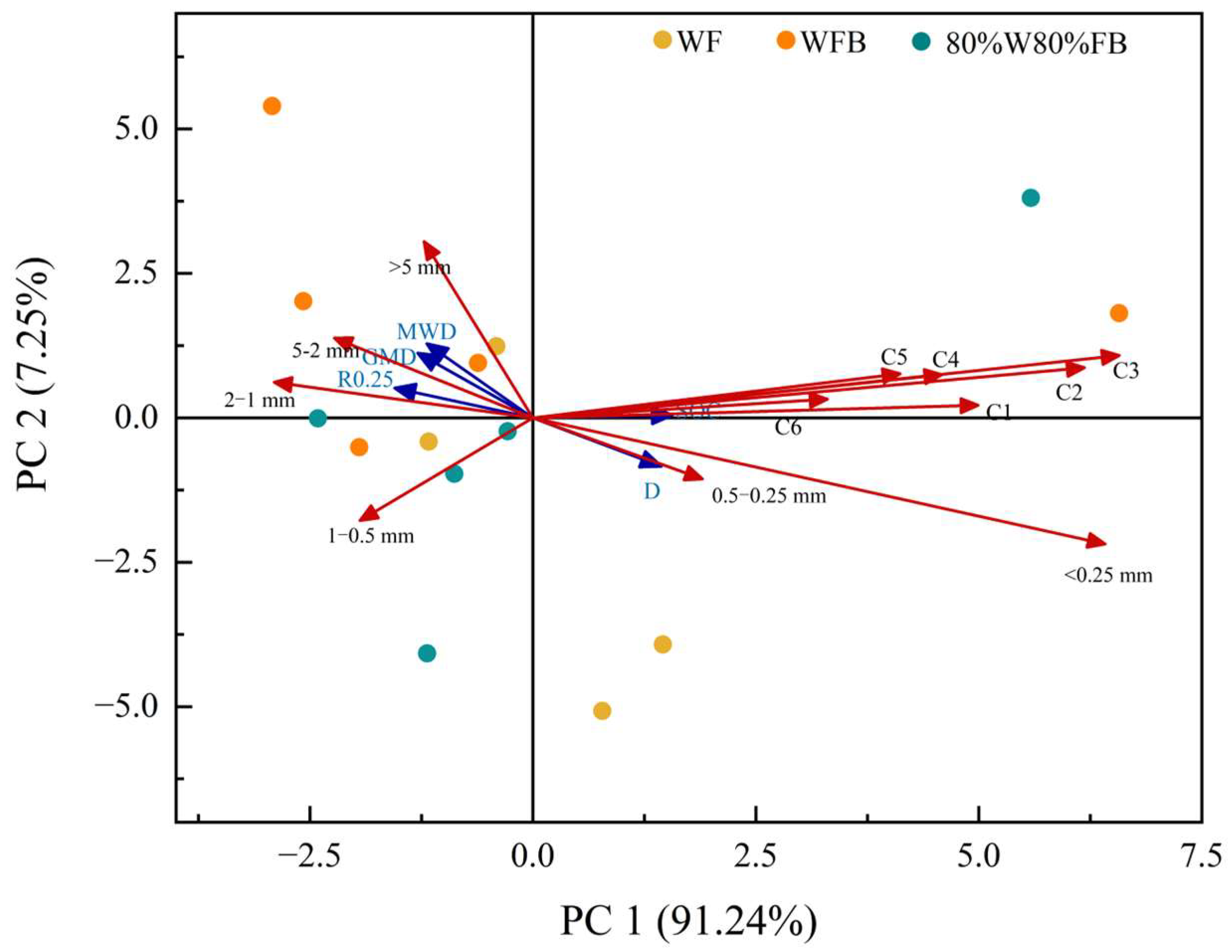Biochar Addition with Water and Fertilization Reduction Increases Soil Aggregate Stability of 0–60 cm Soil Layer on Greenhouse Eggplant in Mollisols
Abstract
1. Introduction
2. Materials and Methods
2.1. Experimental Site
2.2. Experimental Design
2.3. Sample Collection
2.4. Soil Aggregate Classification Method
2.5. Method for Determining Organic Carbon Contents of Whole Soils and Aggregates
2.6. Calculation of Soil Aggregate Stability Indicators
2.7. Statistical Analysis
3. Results
3.1. Effects of Biochar Addition on the Distribution of Soil Aggregates
3.2. Effects of Biochar Addition on Soil Aggregate Stability
3.3. Effects of Biochar Addition on Organic Carbon Contents of Whole Soils and Aggregates
3.4. Correlation Analysis
3.5. Principal Component Factor Analysis
4. Discussion
5. Conclusions
Author Contributions
Funding
Data Availability Statement
Conflicts of Interest
References
- Zhou, J.; Xia, X.J.; Hu, Z.J.; Fan, P.X.; Shi, K.; Zhou, Y.H.; Yu, J.Q. Technological development and production of protected vegetable in China during ‘The Thirteenth Five-year Plan’ and future prospect. China Veg. 2021, 10, 20–34. [Google Scholar] [CrossRef]
- Ouyang, W.; Wu, Y.; Hao, Z.; Zhang, Q.; Bu, Q.; Gao, X. Combined impacts of land use and soil property changes on soil erosion in a mollisol area under long-term agricultural development. Sci. Total Environ. 2022, 36, 1203–1215. [Google Scholar] [CrossRef]
- Yan, Y.; Ji, W.; Li, B.; Wang, G.; Hu, B.; Zhang, C.; Mouazen, A.M. Effects of long-term straw return and environmental factors on the spatiotemporal variability of soil organic matter in the black soil region: A case study. Agronomy 2022, 12, 2532. [Google Scholar] [CrossRef]
- Bis, Z.; Kobyłecki, R.; Ścisłowska, M.; Zarzycki, R. Biochar—Potential tool to combat climate change and drought. Ecohydrol. Hydrobiol. 2018, 18, 441–453. [Google Scholar] [CrossRef]
- Lei, O.; Zhang, R. Effects of biochars derived from different feedstocks and pyrolysis temperatures on soil physical and hydraulic properties. J. Soils Sediments 2013, 13, 1561–1572. [Google Scholar] [CrossRef]
- Zhou, M.; Xiao, Y.; Zhang, X.; Xiao, L.; Ding, G.; Cruse, R.M.; Liu, X. Fifteen years of conservation tillage increases soil aggregate stability by altering the contents and chemical composition of organic carbon fractions in Mollisols. Land Degrad. Dev. 2022, 33, 2932–2944. [Google Scholar] [CrossRef]
- Zhou, M.; Xiao, Y.; Xiao, L.; Li, Y.; Zhang, X.; Richard, M.; Cruse, R.M.; Liu, X. Increased soil aggregate stability by altering contents and chemical composition of organic carbon fractions via seven years of manure addition in Mollisols. Agriculture 2023, 13, 88. [Google Scholar] [CrossRef]
- Paul, B.K.; Vanlauwe, B.; Ayuke, F.; Hoogmoed, M.; Hurisso, T.T.; Koala, S.; Lelei, D.; Ndabamenye, T.; Six, J.; Pulleman, M.M. Medium-term impact of tillage and residue management on soil aggregate stability, soil carbon and crop productivity. Agric. Ecosyst. Environ. 2013, 164, 14–22. [Google Scholar] [CrossRef]
- Wang, J.; Dai, W.; Fang, K.; Gao, H.; Sha, Z.; Cao, L. Nutrient Characterization in Soil Aggregate Fractions with Different Fertilizer Treatments in Greenhouse Vegetable Cultivation. Agriculture 2022, 12, 440. [Google Scholar] [CrossRef]
- Wu, M.; Pang, D.; Chen, L.; Li, X.; Liu, L.; Liu, B.; Li, J.; Wang, J.; Ma, L. Chemical composition of soil organic carbon and aggregate stability along an elevation gradient in Helan Mountains, northwest China. Ecol. Indic. 2021, 131, 108228. [Google Scholar] [CrossRef]
- Walters, R.D.; White, J.G. Biochar in situ decreased bulk density and improved soil-water relations and indicators in southeastern US coastal plain ultisols. Soil Sci. 2018, 183, 99–111. [Google Scholar] [CrossRef]
- Joseph, S.; Cowie, A.L.; Van Zwieten, L.; Bolan, N.; Budai, A.; Buss, W.; Cayuela, M.L.; Graber, E.R.; Ippolito, J.A.; Kuzyakov, Y.; et al. How biochar works, and when it doesn’t: A review of mechanisms controlling soil and plant responses to biochar. GCB Bioenergy 2021, 13, 1731–1764. [Google Scholar] [CrossRef]
- Zhang, S.; Cui, J.; Wu, H.; Zheng, Q.; Zhang, S. Organic carbon, total nitrogen, and microbial community distributions within aggregates of calcareous soil treated with biochar. Agric. Ecosyst. Environ. 2021, 314, 107408. [Google Scholar] [CrossRef]
- Ouyang, L.; Wang, F.; Tang, J.; Yu, L.; Zhang, R. Effects of biochar amendment on soil aggregates and hydraulic properties. J. Soil Sci. Plant Nutr. 2013, 13, 991–1002. [Google Scholar] [CrossRef]
- Fan, Z.; Chao, L. Significance of microbial asynchronous anabolism to soil carbon dynamics driven by litter inputs. Sci. Rep. 2015, 5, 9575. [Google Scholar] [CrossRef]
- Liu, S.; Six, J.; Zhang, H.X.; Zhang, Z.B.; Peng, X.H. Integrated aggregate turnover and soil organic carbon sequestration using rare earth oxides and 13C isotope as dual tracers. Geoderma 2023, 430, 116313. [Google Scholar] [CrossRef]
- Sun, J.N.; Wang, B.C.; Xu, G.; Shao, H.B. Effects of wheat straw biochar on carbon mineralization and guidance for large-scale soil quality improvement in the coastal wetland. Ecol. Eng. 2014, 62, 43–47. [Google Scholar] [CrossRef]
- Wang, Y.L.; Zhou, F.; Zhang, F.; Ma, W.G.; Wang, Q.; Cao, S.L.; Geng, Z.C. Influence of biochar on soil respiration and soil organic carbon fractions. Res. J. Environ. Sci. 2017, 30, 920–928. [Google Scholar]
- Singh, R.; Babu, J.N.; Kumar, R.; Srivastava, P.; Singh, P.; Raghubanshi, A.S. Multifaceted application of crop residue biochar as a tool for sustainable agriculture: An ecological perspective. Ecol. Eng. 2015, 77, 324–347. [Google Scholar] [CrossRef]
- Sohi, S.P.; Krull, E.; Lopez-Capel, E.; Bol, R. A review of biochar and its use and function in soil. Adv. Agron. 2010, 105, 47–82. [Google Scholar] [CrossRef]
- Weber, K.; Quicker, P. Properties of biochar. Fuel 2018, 217, 240–261. [Google Scholar] [CrossRef]
- Mark, G.; Tu, N.; Marissa, M.; Kandis Leslie, G. Physiochemical properties of biochar and activated carbon from biomass residue: Influence of process conditions to adsorbent properties. ACS Omega 2021, 6, 10224–10233. [Google Scholar] [CrossRef]
- Brassard, P.; Godbout, S.; Raghavan, V. Soil biochar amendment as a climate change mitigation tool: Key parameters and mechanisms involved. J. Environ. Manag. 2016, 181, 484–497. [Google Scholar] [CrossRef]
- Shane, M.T.; Peadar, G.L.; Cornelius, J.O.; Mark, G.H. The impact of biochar addition on nutrient leaching and soil properties from tillage soil amended with pig manure. Water Air Soil Pollut. 2014, 225, 1900. [Google Scholar] [CrossRef]
- Lehmann, J.; Rillig, M.C.; Thies, J.; Masiello, C.A.; Hockaday, W.C.; Crowley, D. Biochar effects on soil biota—A review. Soil Biol. Biochem. 2011, 43, 1812–1836. [Google Scholar] [CrossRef]
- Jeffery, S.; Verheijen, F.G.; van der Velde, M.; Bastos, A.C. A quantitative review of the effects of biochar application to soils on crop productivity using meta-analysis. Agric. Ecosyst. Environ. 2011, 144, 175–187. [Google Scholar] [CrossRef]
- Biederman, L.A.; Harpole, W.S. Biochar and its effects on plant productivity and nutrient cycling: A meta-analysis. Glob. Change Biol. Bioenergy 2013, 5, 202–214. [Google Scholar] [CrossRef]
- Lehmann, J.; Cowie, A.; Masiello, C.; Kammann, C.; Woolf, D.; Amonette, J.; Cayuela, M.; Camps-Arbestain, M.; Whitman, T. Biochar in climate change mitigation. Nat. Geosci. 2021, 14, 883–892. [Google Scholar] [CrossRef]
- Lehmann, J.; Gaunt, J.; Rondon, M. Bio-char sequestration in terrestrial ecosystems—A review. Mitig. Adapt. Strateg. Glob. Chang. 2006, 11, 403–427. [Google Scholar] [CrossRef]
- Sun, Z.; Zhang, Z.; Zhu, K.; Wang, Z.; Zhao, X.; Lin, Q.; Li, G. Biochar altered native soil organic carbon by changing soil aggregate size distribution and native SOC in aggregates based on an 8-year field experiment. Sci. Total Environ. 2020, 708, 134829. [Google Scholar] [CrossRef]
- Lee, M.-H.; Chang, E.-H.; Lee, C.-H.; Chen, J.-Y.; Jien, S.-H. Effects of Biochar on Soil Aggregation and Distribution of Organic Carbon Fractions in Aggregates. Processes 2021, 9, 1431. [Google Scholar] [CrossRef]
- Du, Z.L.; Zhao, J.K.; Wang, Y.D.; Zhang, Q.Z. Biochar addition drives soil aggregation and carbon sequestration in aggregate fractions from an intensive agricultural system. J. Soil. Sediment. 2017, 17, 581–589. [Google Scholar] [CrossRef]
- Yang, Y.; Sun, K.; Han, L.F.; Chen, Y.L.; Liu, J.; Xing, B.S. Biochar stability and impact on soil organic carbon mineralization depend on biochar processing, aging and soil clay content. Soil Biol. Biochem. 2022, 169, 108657. [Google Scholar] [CrossRef]
- Jing, Y.; Zhang, Y.; Han, I.; Wang, P.; Mei, Q.; Huang, Y. Efects of diferent straw biochars on soil organic carbon, nitrogen, available phosphorus, and enzyme activity in paddy soil. Sci. Rep. 2020, 10, 8837. [Google Scholar] [CrossRef] [PubMed]
- Wang, Y.; Zhou, M.; Hou, M.; Chen, Y.M.; Sui, Y.Y.; Jiao, X.G. Regulation of nitrogen balance and yield on greenhouse eggplant under biochar addition in Mollisol. Plant Soil Environ. 2022, 68, 36–48. [Google Scholar] [CrossRef]
- Colombo, J.I.; Wilches, J.; Leon, R. Seismic fragility of legged liquid storage tanks based on soil type classifications. J. Constr. Steel Res. 2022, 192, 107212. [Google Scholar] [CrossRef]
- Zhou, M.; Liu, C.; Wang, J.; Meng, Q.; Yuan, Y.; Ma, X.; Liu, X.; Zhu, Y.; Ding, G.; Zhang, J.; et al. Soil aggregates stability and storage of soil organic carbon respond to cropping systems on black soils of Northeast China. Sci. Rep. 2020, 10, 265. [Google Scholar] [CrossRef]
- Peth, S.; Horn, R.; Beckmann, F.; Donath, T.; Fischer, J.; Smucker, A.J.M. Three-dimensional quantification of intra-aggregate pore-space features using synchrotron-radiation-based microtomography. Soil Sci. Soc. Am. J. 2008, 72, 897–907. [Google Scholar] [CrossRef]
- Kong, T.W.; Liu, B.H.; Henderson, M.; Zhou, W.Y.; Su, Y.H.; Wang, S.; Wang, L.G.; Wang, G.B. Effects of shelterbelt transformation on soil aggregates characterization and erodibility in China black soil farmland. Agriculture 2022, 14, 1917. [Google Scholar] [CrossRef]
- Yue, F.X.; Li, J.W.; Qiao, X.X.; Jiao, N.Y.; Yin, F.; Guo, D.Y.; Wang, Y.F.; Liu, L. Effects of biochar application on soil aggregates stability and organic carbon and total nitrogen distribution in the Hilly Area of Western Henan province, China. J. Soil Water Conserv. 2019, 33, 265–272. [Google Scholar] [CrossRef]
- Han, L.F.; Sun, K.; Yang, Y.; Xia, X.H.; Li, F.B.; Yang, Z.F.; Xing, B.S. Biochar’s stability and effect on the content, composition and turnover of soil organic carbon. Geoderma 2020, 364, 114184. [Google Scholar] [CrossRef]
- Hua, L.; Lu, Z.Q.; Ma, H.R.; Jin, S.S. Effect of biochar on carbon dioxide release, organic carbon accumulation, and aggregation of soil. Environ. Prog. Sustain. Energy 2014, 33, 941–946. [Google Scholar] [CrossRef]
- Zhang, Z.H.; Nie, J.; Liang, H.; Wei, C.L.; Wang, Y.; Liao, Y.L.; Lu, Y.H.; Zhou, G.P.; Gao, W.D. The effects of co-utilizing green manure and rice straw on soil aggregates and soil carbon stability in a paddy soil in southern China. J. Integr. Agric. 2023, 22, 1529–1545. [Google Scholar] [CrossRef]
- Nascimento, M.D.; Barreto-Garcia, P.; Monroe, P.; Scoriza, R.; Gomes, V. Interaction between edaphic mesofauna and organic carbon within water-stable aggregates in forestry systems: A case study in northeastern Brazil. Catena 2021, 202, 105269. [Google Scholar] [CrossRef]
- Weng, Z.; Van Zwieten, L.; Singh, B.P.; Tavakkoli, E.; Joseph, S.; Macdonald, L.M.; Rose, T.J.; Rose, M.T.; Kimber, S.W.; Morris, S.; et al. Biochar built soil carbon over a decade by stabilizing rhizodeposits. Nat. Clim. Chang. 2017, 7, 371–376. [Google Scholar] [CrossRef]
- Pokharel, P.; Ma, Z.; Chang, S.X. Biochar increases soil microbial biomass with changes in extra- and intracellular enzyme activities: A global meta-analysis. Biochar 2021, 2, 65–79. [Google Scholar] [CrossRef]






| Fertilization | Irrigation | |||||||||
|---|---|---|---|---|---|---|---|---|---|---|
| 31 May | 16 July | 13 August | 31 May | June– September | ||||||
| Biochar (kg hm−2) | Basal Fertilizer (kg hm−2) | Topdressing (kg hm−2) | Topdressing (kg hm−2) | Irrigation Volume (m3 hm−2) | ||||||
| Organic Fertilizer | N | P2O5 | K2O | N | N | K2O | ||||
| - | 5000 | 72 | 72 | 110 | 70 | 23 | 113 | 27 | 45 | |
| 30,000 | 5000 | 72 | 72 | 110 | 70 | 23 | 113 | 27 | 45 | |
| 30,000 | 5000 | 57.6 | 57.6 | 88 | 56 | 18.4 | 90.4 | 21.6 | 36 | |
| Soil Layer | Treatment | Aggregate Sizes (mm) | |||||
|---|---|---|---|---|---|---|---|
| >5 | 5–2 | 2–1 | 1–0.5 | 0.5–0.25 | <0.25 | ||
| 0–20 (cm) | WF | 0.35 ± 0.22 c | 5.24 ± 0.11 b | 12.35 ± 1.44 a | 23.08 ± 0.46 a | 19.11 ± 1.10 a | 39.88 ± 0.90 b |
| WFB | 3.27 ± 0.11 b | 4.79 ± 0.05 c | 6.19 ± 0.42 c | 15.58 ± 1.34 b | 20.23 ± 3.42 a | 49.94 ± 5.01 a | |
| 80%W80%FB | 5.99 ± 2.21 a | 6.37 ± 0.30 a | 9.55 ± 0.35 b | 16.34 ± 0.40 b | 20.77 ± 0.38 a | 40.97 ± 2.88 b | |
| 20–40 (cm) | WF | 0.76 ± 0.59 b | 4.46 ± 2.47 b | 12.86 ± 1.67 b | 24.61 ± 1.29 a | 18.85 ± 2.81 a | 38.46 ± 2.03 a |
| WFB | 8.94 ± 5.21 a | 12.39 ± 2.82 a | 17.71 ± 1.45 a | 25.80 ± 2.72 a | 11.39 ± 0.02 b | 23.79 ± 3.84 b | |
| 80%W80%FB | 7.25 ± 1.13 a | 12.13 ± 0.01 a | 15.25 ± 0.21 ab | 24.48 ± 1.75 a | 13.86 ± 0.09 b | 27.03 ± 0.73 b | |
| 40–60 (cm) | WF | 7.89 ± 3.08 a | 14.07 ± 0.16 a | 18.34 ± 0.26 b | 21.62 ± 0.50 a | 13.27 ± 0.54 b | 24.80 ± 2.13 a |
| WFB | 6.38 ± 1.89 a | 12.99 ± 1.64 a | 21.70 ± 1.40 a | 28.30 ± 2.28 a | 11.71 ± 0.39 c | 18.92 ± 0.54 b | |
| 80%W80%FB | 0.59 ± 0.24 b | 14.77 ± 4.96 a | 22.02 ± 1.77 a | 26.59 ± 5.67 a | 14.82 ± 1.12 a | 21.21 ± 0.31 b | |
| 60–80 (cm) | WF | 6.34 ± 4.21 ab | 11.32 ± 3.30 a | 17.12 ± 1.13 b | 25.73 ± 3.67 b | 13.56 ± 1.77 a | 20.77 ± 3.25 a |
| WFB | 11.16 ± 3.40 a | 13.19 ± 0.14 a | 26.40 ± 1.78 a | 25.36 ± 2.79 b | 9.94 ± 0.71 b | 13.96 ± 1.54 b | |
| 80%W80%FB | 0.91 ± 0.41 b | 10.41 ± 1.22 a | 15.25 ± 1.76 b | 32.34 ± 0.24 a | 16.10 ± 0.79 a | 24.99 ± 1.54 a | |
| 80–100 (cm) | WF | 6.44 ± 0.80 b | 17.72 ± 6.61 a | 24.02 ± 4.11 a | 22.10 ± 7.01 a | 11.00 ± 1.82 b | 18.72 ± 2.69 a |
| WFB | 19.14 ± 0.28 a | 19.74 ± 0.83 a | 20.62 ± 0.38 a | 20.42 ± 0.32 a | 9.22 ± 0.04 b | 10.86 ± 0.57 b | |
| 80%W80%FB | 7.02 ± 1.79 b | 15.15 ± 1.82 a | 21.50 ± 1.66 a | 27.26 ± 0.02 a | 13.17 ± 0.06 a | 15.90 ± 1.88 a | |
| Soil Layer | Treatment | Stability Index | |||
|---|---|---|---|---|---|
| MWD | GMD | R > 0.25 | D | ||
| 0–20 (cm) | WF | 0.73 ± 0.03 b | 0.50 ± 0.02 ab | 60.12 ± 0.90 a | 2.69 ± 0.01 b |
| WFB | 0.74 ± 0.01 b | 0.45 ± 0.01 b | 50.06 ± 5.01 b | 2.77 ± 0.03 a | |
| 80%W80%FB | 0.97 ± 0.12 a | 0.55 ± 0.05 a | 59.03 ± 2.88 a | 2.70 ± 0.03 b | |
| 20–40 (cm) | WF | 0.74 ± 0.08 b | 0.51 ± 0.04 b | 61.54 ± 2.03 b | 2.68 ± 0.03 a |
| WFB | 1.44 ± 0.31 a | 0.87 ± 0.15 a | 76.21 ± 3.84 a | 2.46 ± 0.07 b | |
| 80%W80%FB | 1.32 ± 0.04 a | 0.78 ± 0.01 a | 72.97 ± 0.73 a | 2.52 ±0.01 b | |
| 40–60 (cm) | WF | 1.44 ± 0.14 a | 0.85 ± 0.07 a | 75.20 ± 2.13 b | 2.48 ± 0.04 a |
| WFB | 1.40 ± 0.11 a | 0.90 ± 0.04 a | 81.08 ± 0.54 a | 2.39 ± 0.00 b | |
| 80%W80%FB | 1.18 ± 0.14 a | 0.79 ± 0.07 a | 78.79 ± 0.31 a | 2.45 ±0.01 a | |
| 60–80 (cm) | WF | 1.33 ± 0.30 ab | 0.83 ± 0.15 b | 78.10 ± 3.18 b | 2.45 ± 0.07 a |
| WFB | 1.68 ± 0.16 a | 1.09 ± 0.11 a | 86.04 ± 1.54 a | 2.26 ± 0.05 b | |
| 80%W80%FB | 1.00 ± 0.04 b | 0.68 ± 0.03 b | 75.01 ± 1.54 b | 2.52 ± 0.03 a | |
| 80–100 (cm) | WF | 1.56 ± 0.27 b | 0.99 ± 0.19 b | 81.28 ± 2.69 b | 2.37 ± 0.08 a |
| WFB | 2.17 ± 0.02 a | 1.40 ± 0.02 a | 89.14 ± 0.57 a | 2.15 ± 0.02 b | |
| 80%W80%FB | 1.50 ± 0.12 b | 0.96 ± 0.07 b | 84.10 ± 1.88 b | 2.34 ± 0.04 a | |
| Literature Sources | Study Area | Soil Type | Main Research Results |
|---|---|---|---|
| Effect of biochar addition on soil aggregates | |||
| Walters et al., 2018 [11] | Williamsdale FarmBiofuels Extension and Research Center in Wallace, NorthCarolina | Soil is a mix of Noboco and Goldsboro series sandy loams | Biochar can improve soil aggregate structure |
| Sun et al., 2014 [17] | Shenyang Agricultural University | Brown earth | All biochar treatments increased small macroaggregates (0.25–2 mm) and the soil aggregate stability |
| Du et al., 2017 [32] | Huantai Experimental Station for Ecological and Sustainability and locates in Shandong Province, China | No-tillage soil in farmland | Biochar can interact with soil organic matter to increase soil aggregation, as well as increase microbial activity and the number of mycorrhizal fungi to promote aggregate formation and stability |
| Yue et al., 2019 [40] | Hilly Area of Western Henan Province, China | Paddy soil | Biochar could increase the content of macroaggregates and enhance the stability of soil aggregates in top layers |
| Our study | Horticultural Branch of the Heilongjiang Academy of Agricultural Sciences | Mollisols | WFB could significantly reduce the content of macroaggregates and decrease the stability of soil aggregates in the top layer, but they increased in 20–100 cm layers; 80%W80%FB significantly increased the stability of soil aggregates in 0–60 cm layers |
| Effect of biochar addition on soil organic carbon and aggregate organic carbon | |||
| Yang et al., 2022 [33] | Shaoguan, Guangdong Province, and Shenyang, Liaoning Province, China | Sandy clay loam and sandy loam | At the end of the incubation, the total carbon loss of biochar-amended soil was 16–53% lower than that of unamended soil, and the lowest carbon loss was found in soils amended with 600 °C biochar |
| Jing et al., 2020 [34] | Changzhou, Jiangsu Province, China | Soil of rice fields | The addition of biochar increased the soil organic carbon content. |
| Yue et al., 2019 [40] | Hilly Area of Western Henan Province, China | Paddy soil | Biochar could increase the OC content of aggregates of different sizes in the different soil layers |
| Our study | Horticultural Branch of the Heilongjiang Academy of Agricultural Sciences | Mollisols | WFB and 80%W80%FB could significantly increase the SOC content of whole soils and the OC content of aggregates in the top layer; WFB could decrease the SOC content of whole soils and the OC content of aggregates in the 20–100 cm soil layer |
Disclaimer/Publisher’s Note: The statements, opinions and data contained in all publications are solely those of the individual author(s) and contributor(s) and not of MDPI and/or the editor(s). MDPI and/or the editor(s) disclaim responsibility for any injury to people or property resulting from any ideas, methods, instructions or products referred to in the content. |
© 2023 by the authors. Licensee MDPI, Basel, Switzerland. This article is an open access article distributed under the terms and conditions of the Creative Commons Attribution (CC BY) license (https://creativecommons.org/licenses/by/4.0/).
Share and Cite
Xu, S.; Zhou, M.; Chen, Y.; Sui, Y.; Jiao, X. Biochar Addition with Water and Fertilization Reduction Increases Soil Aggregate Stability of 0–60 cm Soil Layer on Greenhouse Eggplant in Mollisols. Agronomy 2023, 13, 1532. https://doi.org/10.3390/agronomy13061532
Xu S, Zhou M, Chen Y, Sui Y, Jiao X. Biochar Addition with Water and Fertilization Reduction Increases Soil Aggregate Stability of 0–60 cm Soil Layer on Greenhouse Eggplant in Mollisols. Agronomy. 2023; 13(6):1532. https://doi.org/10.3390/agronomy13061532
Chicago/Turabian StyleXu, Sisi, Meng Zhou, Yimin Chen, Yueyu Sui, and Xiaoguang Jiao. 2023. "Biochar Addition with Water and Fertilization Reduction Increases Soil Aggregate Stability of 0–60 cm Soil Layer on Greenhouse Eggplant in Mollisols" Agronomy 13, no. 6: 1532. https://doi.org/10.3390/agronomy13061532
APA StyleXu, S., Zhou, M., Chen, Y., Sui, Y., & Jiao, X. (2023). Biochar Addition with Water and Fertilization Reduction Increases Soil Aggregate Stability of 0–60 cm Soil Layer on Greenhouse Eggplant in Mollisols. Agronomy, 13(6), 1532. https://doi.org/10.3390/agronomy13061532






